Catalina Swinburn’s woven sculptures reimagine discarded books as vessels of migration, tradition, and knowledge. Her choice of books reflects narratives of diaspora, the transmission of cultural stories, and the expansion of knowledge as her practice builds on the idea of being portable. By incorporating not only pages but also their components, book covers, marble paper, and even eliminated, unprinted pages, the artist engages with what remains unsaid—the secrets within the folds, the absence between the lines that are to be interpreted.
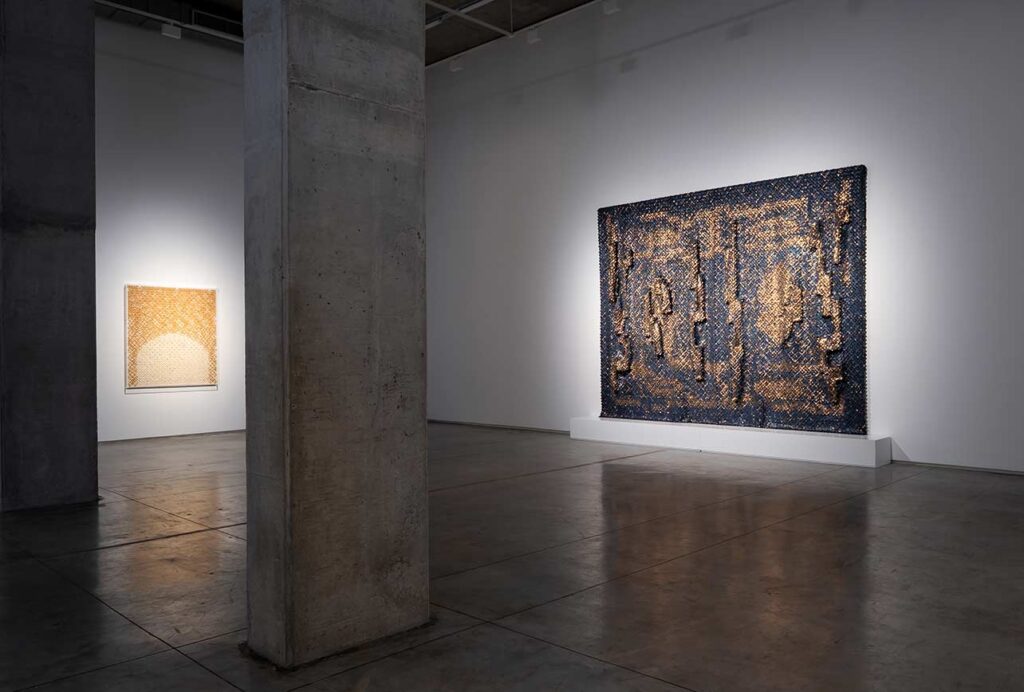
CATALINA SWINBURN CATALINA SWINBURN │ DEVOTIONAL LANDSCAPES
Tunis. 12 May – 25 June
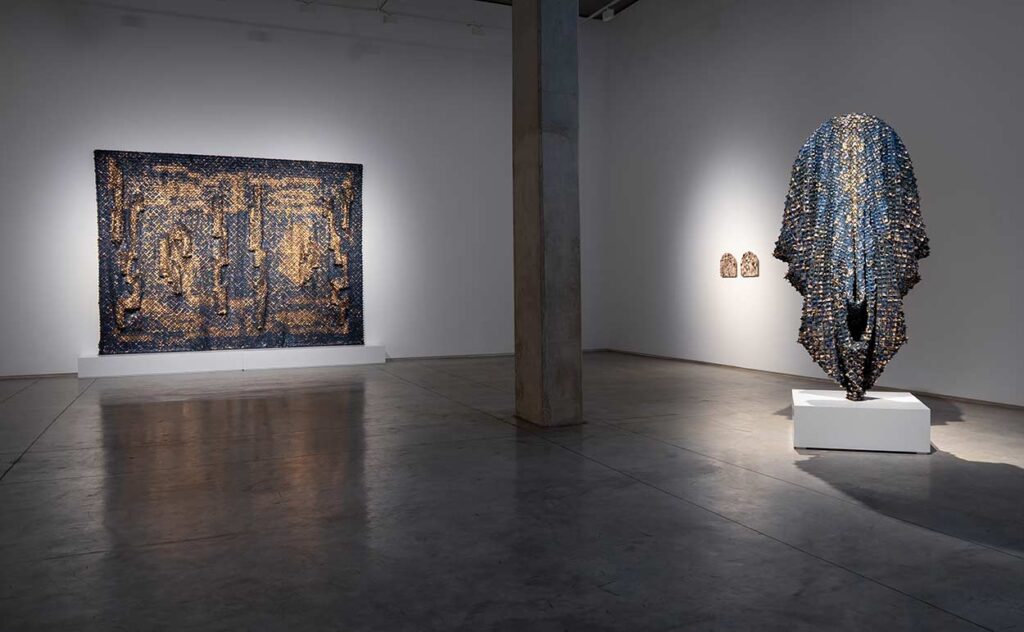
Catalina Swinburn & Mohamed Amine Hamouda © Selma Feriani Gallery
Constellation I embraces the materiality of leather, tinted with blue ink, reminiscent of ancient manuscripts on parchment, not simply because of its durability but also because of its connection to the earth, nature, the divine, and the preservation of knowledge. Inspired by the Blue Quran, the deep blue symbolizes the cosmos for Swinburn, while the gold engravings evoke the sacred and ornamental beauty found in the margins of revered texts. Through the use of floral patterns, the artist employs a divine geometry to denote cosmic harmony and devotion. The intention is to create a work into the series of her previous work where there are intentionally no words or letters—no legibility—but rather putting forward a silence that transcends the written, connecting directly to the spiritual.
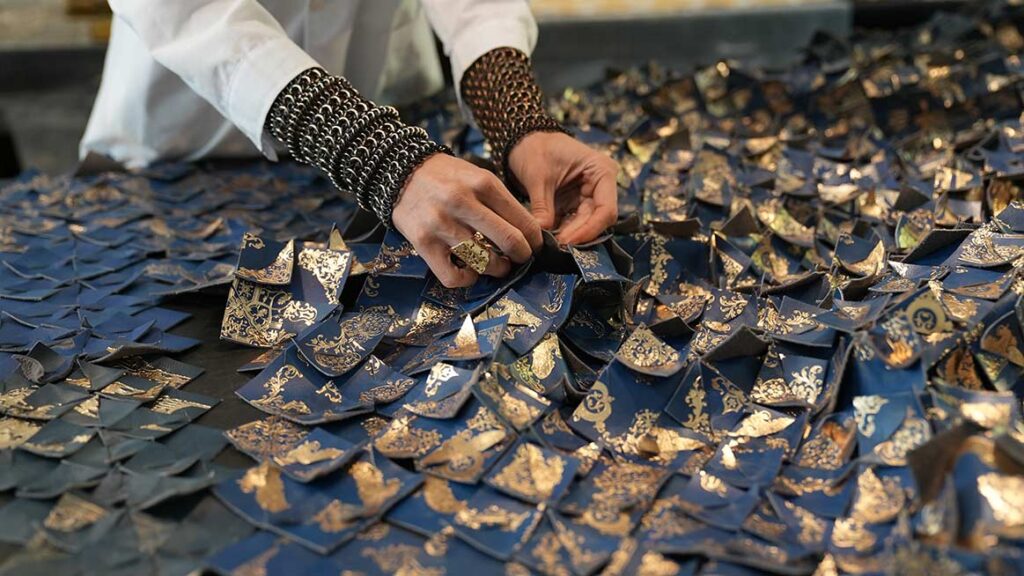
Her handwoven structure embodies a meditation on craft and time. The precise methodology behind the weaving process retains a spiritual practice—a mantra of repetition and contemplation. In this space, where words are mute, the artist seeks to open “a path and a portal for something that is beyond”, to guide us towards some knowledge that exists beyond language, to remind us that not everything needs to be said, for the woven itself speaks what words cannot.
Catalina Swinburn © Selma Feriani Gallery

Catalina Swinburn’s exhibition Devotional Landscapes meditates on the spiritual topography of Zawiyas, common centres or shrines of holiness in the Maghreb, and sanctuaries of spiritual and mystical explorations of Sufism in an Islamic context. She affiliates these sites as conduits of a profound significance of healing and devotion, born from her artistic fieldwork at various religious and archaeological sites across Tunisia, ubiquitous throughout the North African landscape. The exhibition is a contemplative response to her research and to her immersion into the practices and etiquette of this specific spiritual heritage and patrimony. The fruit of her exploration serves as an invitation to reflection, where the physical merges with the transcendental through weaving and sonic textures.
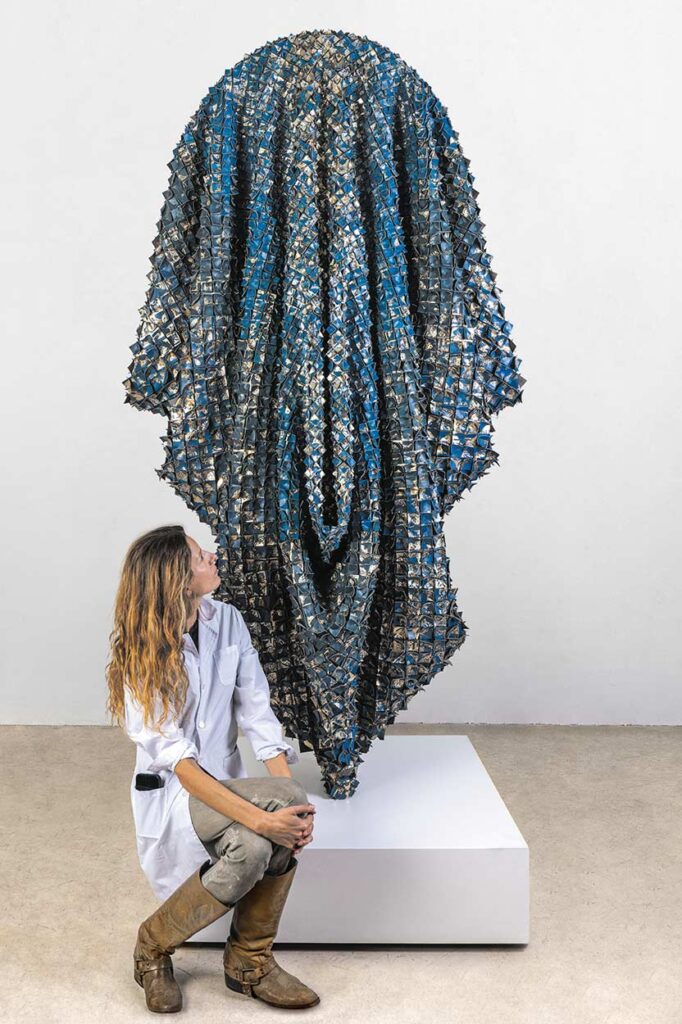
The artist deconstructs and reconfigures the book’s materiality, transforming it into a ritual object. In this work, the hidden and silenced stories of women are made present in the form of a cloak.
Catalina Swinburn © Selma Feriani Gallery
Swinburn’s new body of work straddles both archaeological and contemporary languages; it marks a visual recognition of a geography where architectural notes and landmarks are intertwined in her work, interlocking her materials as if they were a mosaic, retracing connections in the Maghreb through Zawiyas.
Situated across the main space and mezzanine, the exhibition presents sculptural weavings, a collaborative piece with Tunisian artist Mohamed Amine Hamouda, accompanied by a video documenting the process, and a sound piece that combines the movement of ritual music, the weaving of paper, and the interplay of sound and motion.
The exhibition marks the encounter and intersection of two independent practices—Catalina Swinburn and Mohamed Amine Hamouda—where their materials and ends collaboratively overlap. As part of her research, Swinburn made several trips to Gabès, an oasis town in southeastern Tunisia, witnessing Hamouda’s decade-long construction of paper from vegetal scraps in his studio, where they jointly created the paper for their shared project. In the mezzanine space, Swinburn weaves together this paper, made from fibres directly from palm trees from the Oasis of Gabès, utilising palm leaves and natural pigments. This paper was later engraved with local knitting and crochet techniques by local women artisans, culminating in the piece, The Phoenix Rebirth.
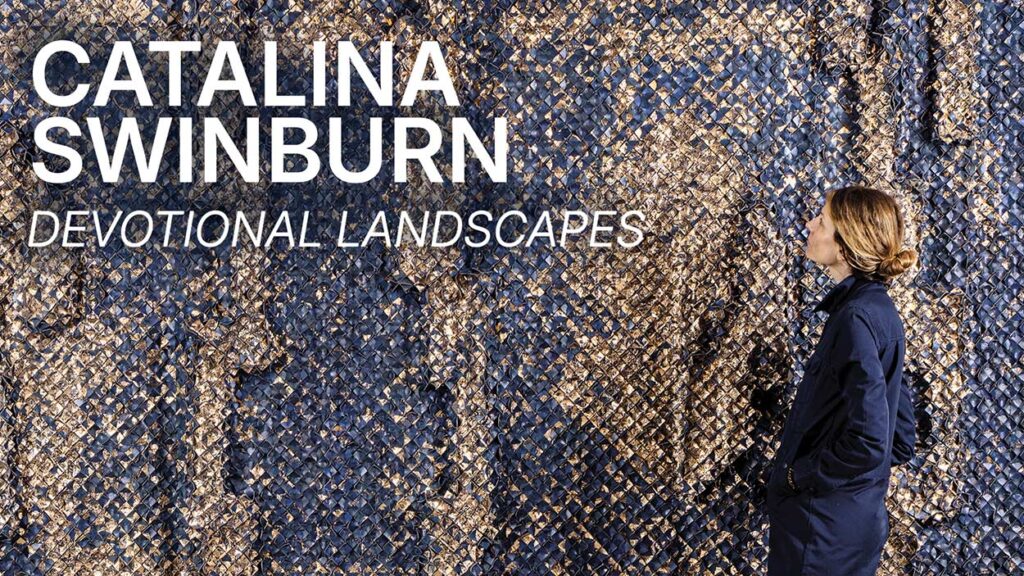
CATALINA SWINBURN
Born 1979. Santiago, Chile
Lives and works in Buenos Aires, Argentina & London, United Kingdom.
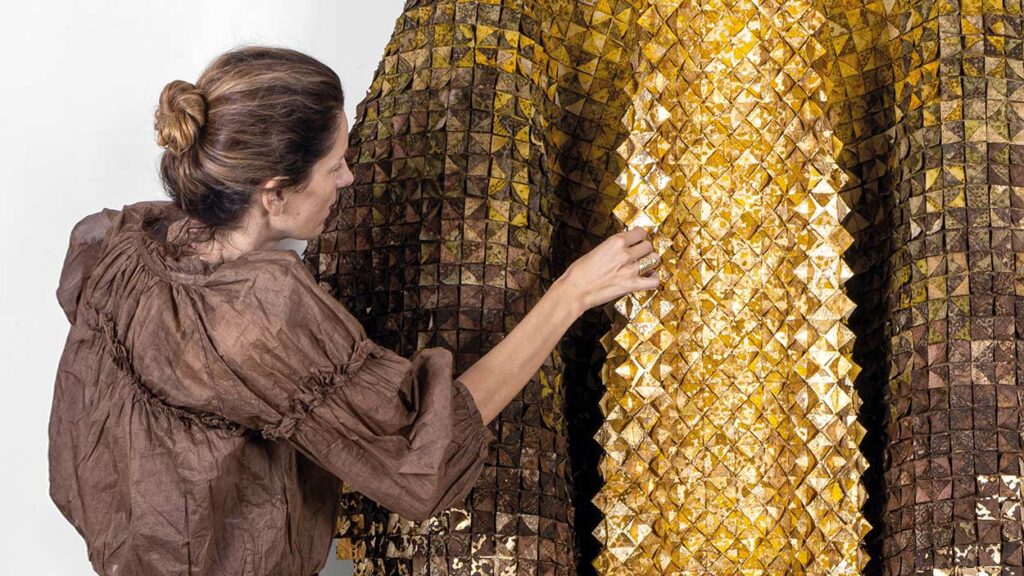
Catalina Swinburn’s work translates into key messages and universal concerns such as sustainability, identity, gender equality, and globalization, underlining the connections of the Global South throughout history. The use of weaving and vintage documents is a vital and dynamic language for raising awareness, both physically and conceptually, while aiming to strengthen the integration between various communities by referencing female resilience. She seeks to rescue ancestral rituals related to sacred places, ancestral geography, and original memory. Regenerating these narratives articulates for the artist both a sense of urgency and a mode of resistance. The artwork is therefore activated by the artist’s position as both fabricator and performer of the sculpture. This could be seen as a metaphor for resistance, where woven narratives are portrayed as a substitute for the silence of women throughout history.

Textiles are eloquent expressions of women’s concern with cultural tradition and transmutation, and are recognized as fundamental to studies of gender, social identity, status, exchange, and modernization. By using weaving as a metaphor for resistance, her practice brings us closer to our cultural identity and offers an alternative view of the function of art as a vehicle of consciousness by meeting various forms of knowledge, opening a dialogue between conservatism and innovation, between continuity and transmutation.
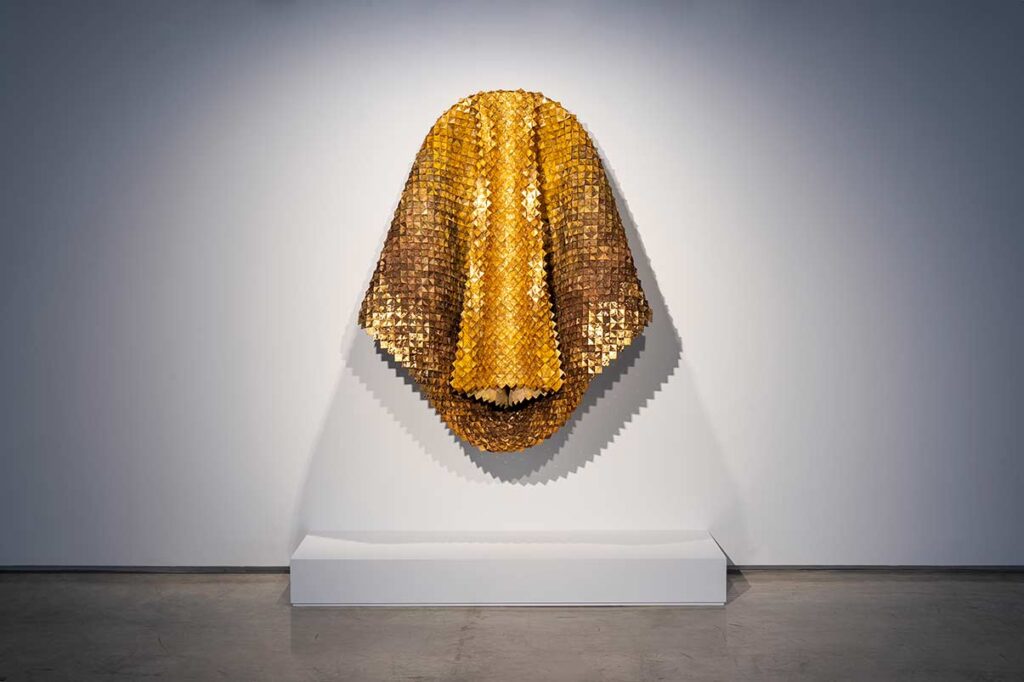
The centerpiece at the exhibition is a collaborative work titled The Phoenix Rebirth, created using handmade paper produced from palm tree fibres gathered from the Oasis of Gabès. This paper was developed in Hamouda’s studio and laboratory, where Swinburn joined him in the making process during several research visits to Gabès.
The final piece, for which Swinburn wove the handmade paper, integrates natural pigments, palm leaves, and is engraved with knitting and crochet cotton cloths crafted by local women artisans, as well as gold leaf.
Catalina Swinburn & Mohamed Amine Hamouda © Selma Feriani Gallery
She received a BA in Fine Arts from the Catholic University of Chile.
Swinburn’s work has been widely exhibited at several institutions, including Centro Cultural Matta, Buenos Aires, Argentina / Museo de la Inmigración, Buenos Aires, Argentina / Mapi Museum, Montevideo, Uruguay / Museo de la Universidad de Antioquia & Museo de la Universidad de Medellin, Medellin / Monnaie du Paris, Pairs, France / MAC Museo de Arte Contemporaneo, Santiago de Chile, Chile / MAVI Museo de Artes Visuales, Santiago de Chile, Chile.
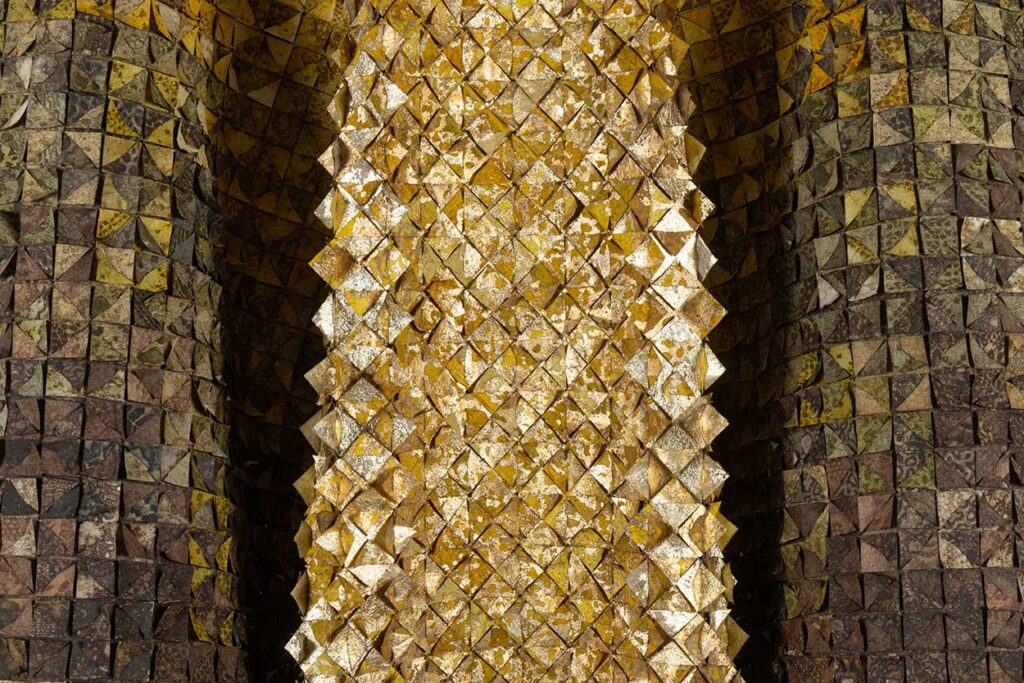
The centerpiece at the exhibition is a collaborative work titled The Phoenix Rebirth, created using handmade paper produced from palm tree fibres gathered from the Oasis of Gabès. This paper was developed in Hamouda’s studio and laboratory, where Swinburn joined him in the making process during several research visits to Gabès.
Swinburn’s work forms part of many prestigious collections of art, including Pilar Citoler Foundation, Cordoba, Spain / Balanz Capital collection, Buenos Aires, Argentina / Latin American Art Collection Artnexus, Bogotá Colombia / CCu Art Collection, Santiago de Chile, Chile / ICC Contemporary Institue of Culture, Sao Paulo, Brazil / Arte Al Dia Collection, Miami, U.S.A / Rosenblum Foundation, Buenos Aires, Argentina / Permanent Public Intervention, Vitacura Parks, Santiago de Chile, Chile.

The centerpiece at the exhibition is a collaborative work titled The Phoenix Rebirth, created using handmade paper produced from palm tree fibres gathered from the Oasis of Gabès. This paper was developed in Hamouda’s studio and laboratory, where Swinburn joined him in the making process during several research visits to Gabès.

